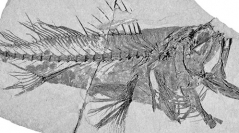

 Comptes Rendus Palevol
8 (6) - Pages 535-544
Comptes Rendus Palevol
8 (6) - Pages 535-544A new genus of sciaenid fish Caucasisciaena is erected to accommodate the Early Miocene eastern Paratethys species Perca ignota Smirnov, 1936, which, subsequently, was variously attributed to the modern genera, either Larimus or Otolithoides. The materials examined include 32 specimens from four Caucasian and Crimean localities of Sakaraulian age (Lower Burdigalian). The new genus is based on a unique combination of features, including: parasphenoid with a dorsal rounded bony flange; basisphenoid present; premaxilla with short ascending process forming obtuse angle with alveolar process and ascending/alveolar process ratio about 0.17; anterior premaxillary teeth enlarged; posttemporal with few robust spines along its posterior margin; presence of 25 vertebrae; presence of three tiny supraneurals; dorsal fin with 11 spines plus 22–24 soft rays; anal fin with two spines and 7–8 soft rays; second anal-fin spine long and massive; pectoral fin elongate; scales ctenoid on body and cycloid on head (except for one or two rows of ctenoid scales on the cheek). Paleoecological considerations suggest that Caucasisciaena probably was a predatory fish that inhabited the coastal waters of the eastern sector of the Paratethyan basin.
Teleostei, Sciaenidae, Caucasisciaena gen. nov., Miocene, Sakaraulian, Caucasus, Crimea, eastern Paratethys